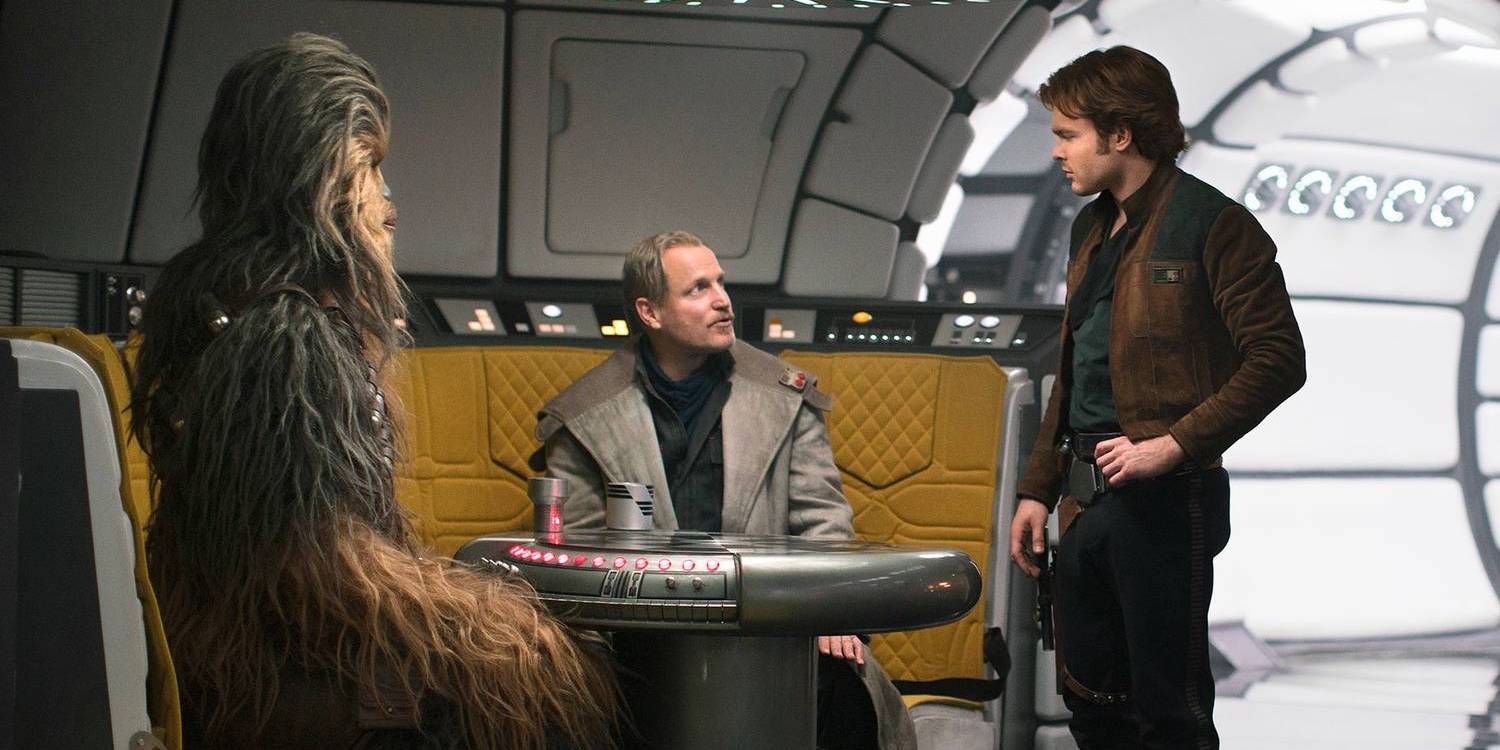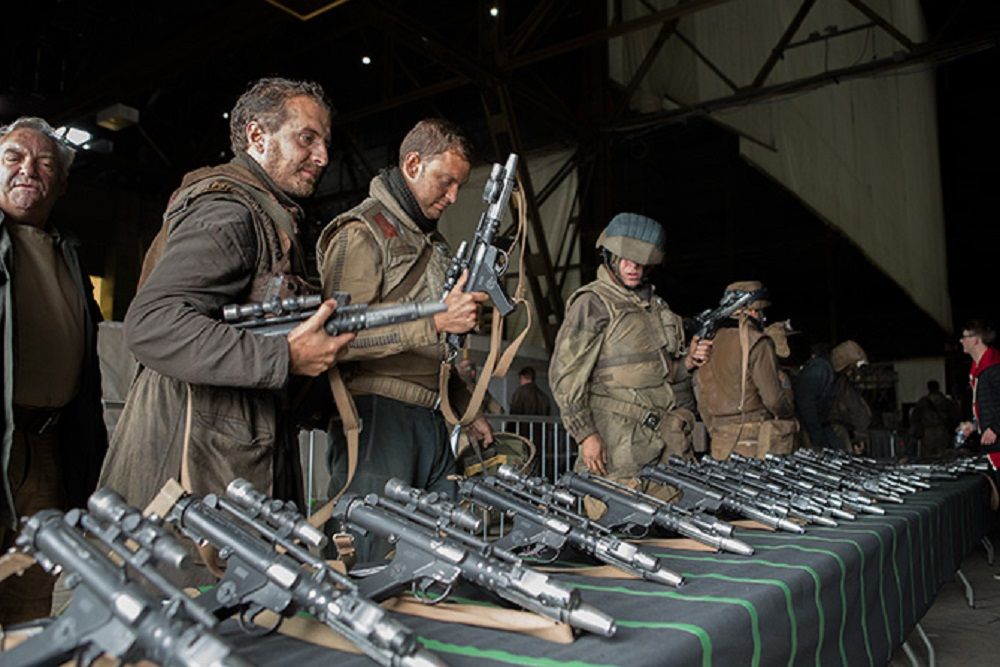
Solo: A Star Wars Story brought audiences to an era between the prequel and original trilogy to explore the youth of everyone's favorite scoundrel, creating a big task for film's production designer, Neil Lamont. While Rogue One: A Star Wars Story, for which he was also a production designer, took place shortly before the original trilogy.
Star Wars prop and set design revolutionized the industry, meaning Neil Lamont had some big shoes to fill not only introducing us to this unexplored time period, but also redesigning classic Star Wars icons like the Millenium Falcon. Screen Rant got to chat with Neil about his experience on the project, how Star Wars design has changed over the years, and the process he uses to create that "Star Wars feel."
Related: Solo Home Video Trailer Is How They Should Have Marketed The Film
Screen Rant: Looking through your history on IMDB, you have a long history in the art department and art department and it looks like you came on to start work as a production designer with Rogue One: A Star Wars Story. Was that a big jump for you, especially jumping into something known for its production design like Star Wars.
Neil Lamont: Yeah, of course. When I went to meet Gareth Edwards, he was up in an office at Pinewood with Doug Chang. We were just finishing Episode VII, on which I was supervising art director and I sort of thought they were looking for a supervising art director. And so I thought I was interviewing for that, so to actually be told halfway through the meeting "we want you for production designer," was, yeah, a massive, massive thrill. It was going to be a massive challenge, and you know what, I, as a supervising art director, thought that it would be a very simple leap to make because I thought I've always wanted to do, but then, yeah, it's a huge leap.
You're really in the fire at this point. There's no place to go and hide. You have to find everything out. You have disappointments and you have a big challenge, you come out smelling like roses sometimes, or a lot of the time, and if not, you also become a problem solver for the production. I've always believed that the art department are sort of a huge conduit of information that feeds a lot of other departments through the film. Especially, of course we see construction and set decoration and props, but special effects depend on us quite a lot. And viz FX depend on us quite a lot. I'm now seeing it really full on first hand.
SR: That's very interesting, especially, like you said, you'd worked in Star Wars before, but coming onto a Star Wars movie specifically in production design, is known for these really immersive worlds. How does that compare to non-Star Wars films that you've done?
NL: Of course, everything. If you're doing a contemporary film, you're mainly concerned with sets and locations, but, of course now with Star Wars with sets locations, dealing with costume, dealing with creatures, we're concepting vehicles, we're concepting weapons, we're concepting set decorations, we're concepting hand props. Everything that we do is manufactured. Everything we design is manufactured. That's a massive, massive challenge to all the departments that are manufacturing, of course. There's no such thing as a stock Star Wars door, so hey, let's draw another Star Wars door, let's make this one different. Lets try to break away from pill shapes, not that you can because they're very good and very memorable, and I think people would miss them, but yes, it's huge because there's so much depth to which we have to go.
SR: Something I've been fascinated with from other interviews I've heard when it comes to recreating that iconic Star Wars look is that there's what Star Wars looks and sounds like, then there's what people think Star Wars looks and sounds like and how it's a challenge to replicate that feeling. You can't just take the audio, for example from the original trilogy and apply it to the new trilogy because it would stand out, but people have this memory of what it sounds like Does that pose a challenge of recreating a feel without just transposing what's been done in that past?
NL: What we've done a lot of is looking at the iconic elements of the design that people will remember and we're trying to do them in a 2016, '17, '18 manufacturing style, and hopefully making it better and more tangible. Back in those days, you sometimes felt that if you leaned up against the wall you might fall through it, but nowadays, it's not. It's extremely well constructed. Not saying it wasn't well constructed in those days, it was just their height of new manufacturing are things that we don't really use anymore. We've moved on and we've gone on to different materials that we manufacture in and that's a huge part. And of course, through props especially, and dressing, there's far more things that are available now that weren't available then. They had to make do with a bit of garden hose, but we don't have to do with a bit of garden hose. We can find a bit of hose that we don't have to do anything to that looks amazing, and somebody may not have seen and will believe it's still Star Wars. But it's then just the accouterments that you add to them to make them Star Wars. Not everybody knows what that Star Wars essence is. It's something I think I understand. It's very hard to describe, but I can just walk across with my supervising art director and we can be standing there and go "that lid on that bin over there feels Star Wars. Let's take it and mold it and let's see what we can make of it. Let's see if there's something we can make from it. Is there a new wall finish there that we can have? Etc. Etc.. So yeah, it's always very interesting.

SR: Especially coming in with Rogue One and Solo, obviously you were in a different role with The Force Awakens, but with the spin-offs, they're going for something a little bit different than the saga stories. Is there a different creative approach to give Rogue One or Solo a different look or feel from traditional Star Wars, or even from each other?
NL: Of course. Everything is in a timeline, so Rogue was slightly before IV of course, and Solo is maybe 5, 6, 7, 8 years ahead of Rogue. So we try to then invoke the sensibilities of where it stood in real time, so Ep. IV was 1975-'76, so therefore Rogue was a bit before that and Solo is maybe late '60s, so we're talking a little bit retro, a little bit lo-fi, what was the best manufacturing around at that time, what was the best looking steel manufacturing plant or electricity generating plant, how could they use that if they had needed that kind of thing back in the '60's to make a Solo movie. The Cold War was a big inspiration as well and early nuclear testing and stuff like that, and that kind of innovative manufacturing really was a big inspiration for us.
SR: The biggest thing with Solo is obviously the Millenium Falcon, speaking of classic inspiration and a new approach, the Falcon we've only seen it in a worn down condition, but this version was a pristine beautiful look. How do you go about establishing what the Falcon was supposed to look like?
NL: The exterior was relatively simple. We always thought we'd fill in the mandibles and we went through various things after, whether it should have something more like a container hanging from the mandible, but then we got this escape pod kind of feeling. So the exterior was kind of simple, and we always knew that would be a skin. And that's also how we treated the interior, too. We, in fact, have a standing set from Episode VII/VIII of the interior of the Falcon, so we looked from that as being a blank canvas. That actual set. We were never going to remove anything from that set to create a new set, we were only going to put our padding, probably initially born of things from maybe the sensibilities of 2001: A Space Odyssey when the Falcon was originally designed back in '74-'75, Harry Lange and people like that who worked on 2001 and were an artist on Episode IV, and we decided to use that padding and cover what was existing there rather than remove anything and build and pretend stuff that we know and love was put in front of it. That doesn't seem to make sense to us.
And also as we were beginning to be going through the Kessel Run, we felt that, if we were going to blow pads and ceiling panels, and have them collapse in frame and shot, we would then want to reveal what was behind them. And that reveal would be of what we all know and love already, what we understand the Han and Chewie Falcon looked like. It was a big thing, and it took a while to get to, but in the end I think we definitely went around it in the most precise way. We didn't blow it. We didn't make the Falcon... the interior didn't become too large or anything like that. It felt the same because we hadn't actually encroached or expanded the interior threshold.
Sept. 14th as the Millennium Falcon sets course digitally in HD and 4K Ultra HD™ and on Movies Anywhere, and bring the adventure home on Blu-ray 4K Ultra HD™, Blu-ray™, DVD and On-Demand on Sept. 25.
MORE: See Ray Park's Full Darth Maul Look From Solo: A Star Wars Story
from ScreenRant - Feed https://ift.tt/2N8Xd95

0 Comments